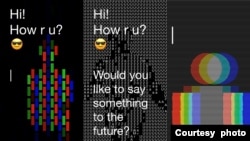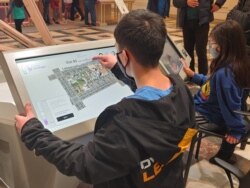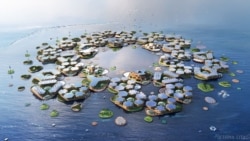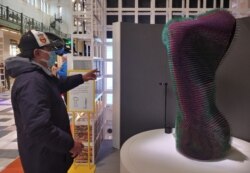A self-driving flying taxi. A super-fast land-based transport vehicle. A sustainable floating city.
Science fiction, or the wave of the future?
The "Futures" exhibit at the Smithsonian Institution in Washington, open Nov. 20, 2021, through July 6, 2022, gives visitors a peek at what may happen in the years to come.
The exhibit opened as part of the 175th anniversary of the Smithsonian and is being held at the Arts and Industries Building, which reopened in November after being closed for almost two decades.
With more than 150 ideas, innovations, technologies and artifacts, the exhibit invites visitors to think about the kind of future in which they want to live.
It also provides food for thought by looking back to past innovations, like an 1800s experimental telephone and a spacesuit-testing android.
The exhibit was designed by the Lab of Rockwell Group, an architecture and exhibit design firm in New York.
"The exhibition opens up many different possible forms that the future can take, capturing a number of small glimpses of conceivable futures," said David Tracy, director of creative technology at Rockwell.
The company designed cutting-edge installations called beacons that contain multiple- choice questions that "prompt people's imaginations and get them to think about the kind of future they want to see," Tracy told VOA.
To answer the questions, people use hand gestures or hover over an answer, Tracy said, which also provides "health and safety measures, since you don't have to touch a screen."
Not surprisingly, there are more questions than answers.
It's difficult for people "to imagine how the future may be different and the technologies that might make it different," said Jane McGonigal, director of game research and development at the Institute for the Future in Palo Alto, California.
McGonigal provided the questions for visitors to ponder "to help them imagine the future more vividly and optimistically," she said during an interview with VOA.
Questions include, "When might moon tourism become a real reality?" Another looks at what the future might be like if meat doesn't come from an animal but is grown in a laboratory.
Visitor Raj Goel from New York got a taste of what that might be like as he peered into a display that was set up like a deli counter with possible food in the future.
Goel said he's concerned about meat being grown in a lab. But he said he liked the idea of mushrooms being used as a sort of meatless meat.
"It's supposed to taste like bacon and would be a lot healthier," he said.
Goel said "Futures" makes him feel a bit like he's walked into a science fiction movie.
"It's like a giant arcade of futuristic toys and ideas," he told VOA.
Those ideas include a BioSuit, a skintight spacesuit that provides astronauts with greater mobility, and an environmentally friendly cleaning system that washes clothes using water from wetlands.
Human remains can also be put to good ecological use.
A biodegradable underground burial capsule offers a sustainable way to use human remains to grow a tree.
With concern over climate change, cleaner transportation ideas are presented.
Among them, the Virgin Hyperloop, a futuristic transport tube that could become a new mode of train-like transportation and have "a lower environmental impact than other modes of mass transportation," Virgin said on its hyperloop website. The system could propel passenger or cargo pods at speeds of more than 1,000 kilometers per hour, Virgin said, three times faster than high-speed rail.
Another possible innovation is an autonomous flying machine.
The Bell Nexus company has an idea for a flying taxi, especially for use in crowded cities.
The air taxi, powered by hybrid-electric propulsion, resembles a helicopter and has six tilting round fans that enable it to take off and land vertically from a rooftop or a launch pad.
The interactive displays were especially popular with visitors.
A robotic art installation called "Do Nothing with Al" mimics the slow moves of a person standing in front of it. The idea is to encourage people to slow down and relax in this era of technological overload.
"It's really fascinating," said Jan Myers from Denver. "It reminds me of a human torso with needles," she said, as she moved back and forth, watching the robot follow her movements.
At a portal called "Hi! How r u?" visitors can strike up holographic conversations by using an avatar to leave personal messages for people in the future. They can also interact in real time with people at a paired portal site in Doha, Qatar.
Tracy said he hoped the exhibit "empowered visitors with a sense of optimism about our future."
Goel said he was encouraged "because many things I saw here made me think the future is bright."









